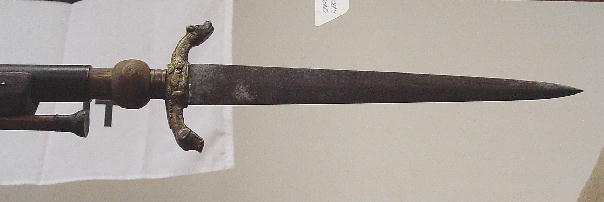
This bayonet was designed to fit the various large caliber muskets commonly found in Colonial America in the 1700s. It was used
by "plugging" the wood hilt into the muzzle of the firearm's barrel. The problem this created was that the firearm was
rendered temporarily useless; even worse, more permanent if the "plug" bayonet became jammed and could not be removed. This design was
eventually replaced by the "socket bayonet" as the firearm could be fired with that design through the "muzzle" of the socket, while attached
to the barrel muzzle.
Hilt is wood with silver cap, silver ferrule, iron cross-guard.
Straight, double-edged spear-tip blade; unfullered.
This example is extremely well made and is obviously the work of a master craftsman.
Manufacturer's mark on this specimen is "E H" and believed to be the work of Edward Hunt from Philadelphia, Pennsylvania - a known Silversmith and
Cutler from 1700 to about 1725.


